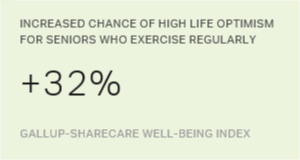Story Highlights
- Exercise has mental and emotional health benefits across all age groups
- Benefits of regular exercise are greatest for those aged 45 and older
- Odds of having a positive life outlook are 32% greater for seniors who exercise
WASHINGTON, D.C. -- The amount of exercise that Americans get is closely linked to their level of optimism about their lives. However, this relationship is much stronger among older adults than it is among younger adults. U.S. adults aged 65 and older who report exercising regularly (30+ minutes at least three days the prior week) are 32% more likely than those who say they did not exercise at all to have high optimism. This compares with a 6% bump for those younger than 30 who exercise regularly.
| 18-29 | 30-44 | 45-64 | 65+ | |||||||||||||||||||||||||||||||||||||||||||||||||||||||||||||||||||||||||||||||||||||||||||||||||
|---|---|---|---|---|---|---|---|---|---|---|---|---|---|---|---|---|---|---|---|---|---|---|---|---|---|---|---|---|---|---|---|---|---|---|---|---|---|---|---|---|---|---|---|---|---|---|---|---|---|---|---|---|---|---|---|---|---|---|---|---|---|---|---|---|---|---|---|---|---|---|---|---|---|---|---|---|---|---|---|---|---|---|---|---|---|---|---|---|---|---|---|---|---|---|---|---|---|---|---|---|
| % | % | % | % | |||||||||||||||||||||||||||||||||||||||||||||||||||||||||||||||||||||||||||||||||||||||||||||||||
| Days with 30+ minutes of exercise prior week: | ||||||||||||||||||||||||||||||||||||||||||||||||||||||||||||||||||||||||||||||||||||||||||||||||||||
| 0 days | 78.5 | 73.5 | 57.0 | 43.0 | ||||||||||||||||||||||||||||||||||||||||||||||||||||||||||||||||||||||||||||||||||||||||||||||||
| 1-2 days | 79.0 | 78.9 | 66.0 | 49.6 | ||||||||||||||||||||||||||||||||||||||||||||||||||||||||||||||||||||||||||||||||||||||||||||||||
| 3+ days | 83.2 | 81.2 | 70.1 | 56.6 | ||||||||||||||||||||||||||||||||||||||||||||||||||||||||||||||||||||||||||||||||||||||||||||||||
| Effects of regular exercise: | ||||||||||||||||||||||||||||||||||||||||||||||||||||||||||||||||||||||||||||||||||||||||||||||||||||
| Percentage-point difference (3+ vs. 0 days) | 4.7 | 7.7 | 13.1 | 13.6 | ||||||||||||||||||||||||||||||||||||||||||||||||||||||||||||||||||||||||||||||||||||||||||||||||
| Increased chance of high life optimism (3+ vs. 0 days) | +6% | +11% | +23% | +32% | ||||||||||||||||||||||||||||||||||||||||||||||||||||||||||||||||||||||||||||||||||||||||||||||||
| "In the last seven days, on how many days did you exercise for 30 or more minutes?" | ||||||||||||||||||||||||||||||||||||||||||||||||||||||||||||||||||||||||||||||||||||||||||||||||||||
| Gallup-Sharecare Well-Being Index | ||||||||||||||||||||||||||||||||||||||||||||||||||||||||||||||||||||||||||||||||||||||||||||||||||||
These results are based on interviews with nearly 270,000 U.S. adults between Jan. 2, 2016, and July 20, 2017, as part of the Gallup-Sharecare Well-Being Index. To measure Americans' future life optimism, respondents are asked to rate their life "five years from now" using an imaginary ladder with steps numbered from zero to 10, based on the Cantril Self-Anchoring Striving Scale. Those who rate their future life an 8 or higher are considered highly optimistic.
Future life ratings, regardless of exercise level, drop steadily as age increases -- but participation in regular exercise significantly mitigates this pattern.
Exercise Associated With Lower Depression, Less Stress
In addition to high life optimism, exercise is also linked to a reduced likelihood of having been diagnosed with depression during one's lifetime. As with life optimism, the benefits of exercise appear stronger among older adults, particularly those aged 45 to 64. Within this age group, those who exercise regularly are 45% less likely than those who do not exercise to report having been diagnosed with depression at some point in their lifetime.
Seniors who exercise regularly are 42% less likely than those who don't exercise to report depression diagnoses. Younger adults who exercise regularly also have lower odds of being diagnosed with depression, although the relationship is not as strong as it is among older adults.
| 18-29 | 30-44 | 45-64 | 65+ | |||||||||||||||||||||||||||||||||||||||||||||||||||||||||||||||||||||||||||||||||||||||||||||||||
|---|---|---|---|---|---|---|---|---|---|---|---|---|---|---|---|---|---|---|---|---|---|---|---|---|---|---|---|---|---|---|---|---|---|---|---|---|---|---|---|---|---|---|---|---|---|---|---|---|---|---|---|---|---|---|---|---|---|---|---|---|---|---|---|---|---|---|---|---|---|---|---|---|---|---|---|---|---|---|---|---|---|---|---|---|---|---|---|---|---|---|---|---|---|---|---|---|---|---|---|---|
| % | % | % | % | |||||||||||||||||||||||||||||||||||||||||||||||||||||||||||||||||||||||||||||||||||||||||||||||||
| Days with 30+ minutes of exercise prior week: | ||||||||||||||||||||||||||||||||||||||||||||||||||||||||||||||||||||||||||||||||||||||||||||||||||||
| 0 days | 22.1 | 23.0 | 28.2 | 21.2 | ||||||||||||||||||||||||||||||||||||||||||||||||||||||||||||||||||||||||||||||||||||||||||||||||
| 1-2 days | 18.5 | 18.4 | 20.3 | 16.7 | ||||||||||||||||||||||||||||||||||||||||||||||||||||||||||||||||||||||||||||||||||||||||||||||||
| 3+ days | 15.9 | 15.5 | 15.6 | 12.4 | ||||||||||||||||||||||||||||||||||||||||||||||||||||||||||||||||||||||||||||||||||||||||||||||||
| Effects of regular exercise: | ||||||||||||||||||||||||||||||||||||||||||||||||||||||||||||||||||||||||||||||||||||||||||||||||||||
| Percentage-point difference (3+ vs. 0 days) | -6.2 | -7.5 | -12.6 | -8.8 | ||||||||||||||||||||||||||||||||||||||||||||||||||||||||||||||||||||||||||||||||||||||||||||||||
| Decreased chance of depression (3+ vs. 0 days) | -28% | -33% | -45% | -42% | ||||||||||||||||||||||||||||||||||||||||||||||||||||||||||||||||||||||||||||||||||||||||||||||||
| "In the last seven days, on how many days did you exercise for 30 or more minutes?" | ||||||||||||||||||||||||||||||||||||||||||||||||||||||||||||||||||||||||||||||||||||||||||||||||||||
| Gallup-Sharecare Well-Being Index | ||||||||||||||||||||||||||||||||||||||||||||||||||||||||||||||||||||||||||||||||||||||||||||||||||||
Regular exercise also appears to more greatly reduce daily stress for older Americans. Seniors in particular are much less likely than their younger counterparts to report significant stress on any given day, regardless of how often they exercise. But the relationship between exercise and reduced stress is again greatest among those aged 45 and up, with regular exercisers in this group being 25% less likely than non-exercisers to report significant daily stress. This compares with an 11% reduction in daily stress among regular exercisers younger than 30.
| 18-29 | 30-44 | 45-64 | 65+ | |||||||||||||||||||||||||||||||||||||||||||||||||||||||||||||||||||||||||||||||||||||||||||||||||
|---|---|---|---|---|---|---|---|---|---|---|---|---|---|---|---|---|---|---|---|---|---|---|---|---|---|---|---|---|---|---|---|---|---|---|---|---|---|---|---|---|---|---|---|---|---|---|---|---|---|---|---|---|---|---|---|---|---|---|---|---|---|---|---|---|---|---|---|---|---|---|---|---|---|---|---|---|---|---|---|---|---|---|---|---|---|---|---|---|---|---|---|---|---|---|---|---|---|---|---|---|
| % | % | % | % | |||||||||||||||||||||||||||||||||||||||||||||||||||||||||||||||||||||||||||||||||||||||||||||||||
| Days with 30+ minutes of exercise prior week: | ||||||||||||||||||||||||||||||||||||||||||||||||||||||||||||||||||||||||||||||||||||||||||||||||||||
| 0 days | 52.5 | 52.0 | 47.3 | 27.0 | ||||||||||||||||||||||||||||||||||||||||||||||||||||||||||||||||||||||||||||||||||||||||||||||||
| 1-2 days | 52.9 | 50.1 | 43.2 | 23.9 | ||||||||||||||||||||||||||||||||||||||||||||||||||||||||||||||||||||||||||||||||||||||||||||||||
| 3+ days | 46.8 | 43.7 | 36.2 | 19.6 | ||||||||||||||||||||||||||||||||||||||||||||||||||||||||||||||||||||||||||||||||||||||||||||||||
| Effects of regular exercise: | ||||||||||||||||||||||||||||||||||||||||||||||||||||||||||||||||||||||||||||||||||||||||||||||||||||
| Percentage-point difference (3+ vs. 0 days) | -5.7 | -8.3 | -11.1 | -7.4 | ||||||||||||||||||||||||||||||||||||||||||||||||||||||||||||||||||||||||||||||||||||||||||||||||
| Decreased chance of daily stress (3+ vs. 0 days) | -11% | -16% | -24% | -27% | ||||||||||||||||||||||||||||||||||||||||||||||||||||||||||||||||||||||||||||||||||||||||||||||||
| "In the last seven days, on how many days did you exercise for 30 or more minutes?" | ||||||||||||||||||||||||||||||||||||||||||||||||||||||||||||||||||||||||||||||||||||||||||||||||||||
| Gallup-Sharecare Well-Being Index | ||||||||||||||||||||||||||||||||||||||||||||||||||||||||||||||||||||||||||||||||||||||||||||||||||||
Implications
This analysis underscores the importance of exercise to many aspects of well-being as people age. While exercise is associated with increased odds of having a positive life outlook -- and reduced odds of depression and stress -- its apparent benefits in relation to these outcomes are much greater among older Americans. One possible reason for this: Older adults often have slowing metabolisms and deteriorating physical health, thereby giving exercise more opportunity to make a big impact among this population.
The relationships between exercise and positive emotional health outcomes can go in both directions. For example, those who are depressed may have less motivation to exercise than those who are not. However, it is also likely that those who exercise regularly get a mental health boost that helps ward off depression. As such, the importance of exercise in improving the odds for positive emotional health outcomes remains intact.
The value of exercise for older Americans is particularly important in light of previous Gallup and Sharecare research finding that for older Americans, exercise is more closely tied to health than diet or smoking is. These findings point to the urgency of implementing programs that educate older Americans about exercise and make it easier and safer for them to do so. The results also highlight the need for communities to invest in infrastructures that support active living -- a proven method for enhancing exercise and for reaping its benefits.
View exercise rankings for 189 U.S. communities in the State of American Well-Being: 2016 Community Rankings for Exercise report.

Gallup Analytics
Subscribe to our online platform and access nearly a century of primary data.
Survey Methods
These results are based on telephone interviews conducted Jan. 2, 2016, through July 20, 2017, as part of the Gallup-Sharecare Well-Being Index survey, with a random sample of 269,467 adults aged 18 and older, living in all 50 U.S. states and the District of Columbia. This includes over 39,000 respondents in each reported age group. For each reported age group, the margin of sampling error is no more than ±0.6 percentage points at the 95% confidence level, including the computed design effects for weighting.
Each sample of national adults includes a minimum quota of 60% cellphone respondents in 2016 and 70% cellphone respondents in 2017, with additional minimum quotas by time zone within region. Landline and cellular telephone numbers are selected using random-digit-dial methods.
Learn more about how the Gallup-Sharecare Well-Being Index works.


